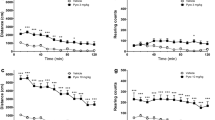Abstract
Intravenous administration ofl-stepholidine (SPD), a dopamine (DA) receptor antagonist, increased the firing rate of DA neurons located in the ventral tegmental area (VTA) and substantia nigra pars compacta (SNC) in both anaesthetized and paralyzed rats. However, with the increase of dose, SPD selectively inhibited the firing activity of DA neurons in the VTA but not in the SNC. The inhibition was reversed by the DA agonist apomorphine (APO), suggesting that it may be via the mechanism of depolarization inactivation (DI). In rats, chronic adrninistration of SPD for 21 d dose-dependently decreased the number of spontaneously active DA neurons in the VTA, of which effect was reversed by APO (i. v.). In contrast, the same treatment failed to affect the population of DA neurons in the SNC. Similarly, the acute treatment of SPD also decreased the number of spontaneously firing DA neurons in the VTA, but not in the SNC. SPD per se only induced very weak catalepsy. Its catalepsy which was not in proportion to dosage was only observed in the dose range of 10–40 mg/kg and lasted 15 min. SPD effectively antagonized the APO (2 mg/kg, i. p.)-induced stereotypy.The above-mentioned results suggest that SPD selectively inactivates the DA neurons in the VTA not in the SNC. SPD may associate with a low incidence of extrapyramidal side-effects and may be ranked as a promising compound for searching for a new kind of atypical neuroleptics.
Similar content being viewed by others
References
Jin, G.Z., Sun, B. C., The advancement of l-stepholidine and its analogues on brain dopamine receptors,Prog. Natur. Sci. (in Chinese), 1995, 5: 55.
Sun, B. C., Jin, G. Z., Effects of ( - )-stepholidine on firing activity of dopamine neurons in ventral tegmental area of rats,Acta Pharmacol. Sin., 1992, 13: 395.
Sun, B. C., Jin, G. Z., Characteristics of ( - )-stepholidine on the firing activity of substantia nigral dopamine neurons after repeated reserpine treatment,Biol. Signals, 1990, 1: 331.
Meltzer, H. Y., Stahi, S.M., The dopamine hypothesis of Schizophrenia: A review,Schizophrenia Bull., 1976, 2: 19.
Paxinos, G., Watson, C., The Rat Brain in Stereotaxic Coordinates, Sydney: Academic Press, 1982.
Chiodo, L.A., Bunney, B.S., Typical and atypical neuroleptics: differential effects of chronic administration on the activity of A9 and A10 midbrain dopaminergic neurons,J. Neurosci., 1983, 3: 1607.
Christensen, A. V., Arnt, J., Svendsen, O., Catecholumines Part C: Neuropharmacology and Central Nervous System — Therapeutic Aspects, New York: Alan R Liss Inc., 1984, 99–109.
Costall, B., Naylor, R.J., The role of telencephalic dopaminergic systems in the mediation of apomorphine stereotyped behavior,Eur. J. Pharmacol., 1973, 24: 8.
Grenhoff, J., Ugedo, L., Svensson, T.H., Firing patterns of midbrain dopamine neurons: differences between A9 and A10 cells,Acta Physiol. Scan., 1988, 134: 127.
Chiodo, L.A., Bunney, B.S., Possible mechanisms by which repeated clozapine administration differentially affects the activity of two subpopulations of midbrain dopamine neurons,J. Neurosci., 1985, 5: 2539.
Grace, A.A., Bunney, B. S., Intracellular and extracellular electrophysiology of nigral dopamine neurons: I. Identification and characterization,Neuroscience, 1983, 10: 301.
Meltzer, H.Y., Matsubara, S., Lee, J.C., Classification of typical and atypical antipsychotic drugs on the basis of dopamine D-1, D-2 and serotonin 2 pKi values,J. Pharmacol. Exp. Ther., 1989, 251: 238.
Beckmann, B., Hippius, H., Riither, E., Treatment of schizophrenia,Prog. Neuro-Psychopharmacol., 1979, 3: 47.
Cai, N., Jin, G.Z., Zhang, Z.D., Controlled study on treatment of tardive dyskinesia by l-stepholidine,Chin. J. Neurol. Psychi. (in Chinese), 1988, 21: 281.
Author information
Authors and Affiliations
Additional information
Project supported by the National Natural Science Foundation of China.
Rights and permissions
About this article
Cite this article
Zhang, X., Sun, B. & Jin, G. Atypical neuroleptic properties ofl-stepholidine. Sci. China Ser. C.-Life Sci. 40, 531–538 (1997). https://doi.org/10.1007/BF03183593
Received:
Issue Date:
DOI: https://doi.org/10.1007/BF03183593




